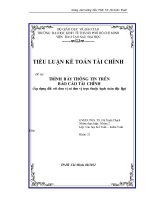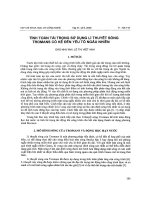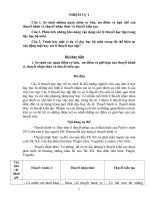Tại sao người dùng lại sáng tạo nội dung - ứng dụng của thuyết hành vi có kế hoạch
Bạn đang xem bản rút gọn của tài liệu. Xem và tải ngay bản đầy đủ của tài liệu tại đây (1.46 MB, 7 trang )
Chuyên mục: Quản trị KD & Marketing - TẠP CHÍ KINH TẾ & QUẢN TRỊ KINH DOANH SỐ 08 (2018)
TẠI SAO NGƢỜI DÙNG LẠI SÁNG TẠO NỘI DUNG - ỨNG DỤNG
CỦA THUYẾT HÀNH VI CÓ KẾ HOẠCH
Zhou Xiao Hong1, Bùi Thị Thúy2
Tóm tắt
Lý thuyết về hành vi có kế hoạch (TPB) kể từ khi phát triển khoảng 30 năm trước đã được chứng minh
là một cách tiếp cận mạnh mẽ để giải thích hành vi của con người. Nó đã được áp dụng thành công cho
một loạt các hành vi. Theo lý thuyết, hành vi của người tiêu dùng là một chức năng của ý định thực hiện
hành vi được đề cập; hành vi dựa trên thái độ, chuẩn mực chủ quan và kiểm soát hành vi đối với hành
vi; và các yếu tố này được xác định, tương ứng, bởi thái độ đối cá nhân đối với hành vi, chuẩn mực và
kiểm soát. Với sự phát triển của công nghệ, nội dung do người dùng tạo ra (UGC) được coi là một phần
của truyền miệng điện tử, được tạo ra và chia sẻ giữa người tiêu dùng có tầm quan trọng lớn đối với các
nhà tiếp thị. Nghiên cứu này giải thích lý do tại sao người dùng tham gia vào việc tạo nội dung. Lý
thuyết về hành vi có kế hoạch (TPB) đã được sử dụng để giải thích hành vi này. Thông qua một số câu
hỏi khảo sát đã được thực hiện vào tháng 10/2018, sử dụng SPSS 16 với 78 người đã được hỏi về thông
tin liên quan đến nội dung được tạo và chia sẻ trên internet, kết quả kiểm tra cho thấy ý định tạo nội
dung của người dùng được xác định theo thái độ cá nhân, chuẩn mực và kiểm soát.
Từ khóa: Lý thuyết về hành vi có kế hoạch (TPB), nội dung do người dùng tạo ra (UGC), truyền miệng
điện tử (eWOM).
WHY USERS GENERATE CONTENT
AN APPLICATION OF THE THEORY OF PLANNED BEHAVIOR
Abstract
The theory of planned behavior (TPB) since its apprerance about 30 years ago has been proved to be a
powerful approach to explain human behavior. It has been successfully applied to a variety of
behaviors. According to the theory, the consumer’s behavior is a function of intention to perform the
behavior in question; the behavior is based on attitude, subjective norm, and perceived behavioral
control; and these factors are determined, respectively, by behavioral, normative, and control beliefs.
With the development of technology, the user-generated content (UGC) is considered as a part of
electronic word of mouth created and shared between consumers, which has a major importance to
marketers. This study explains why users are involved in creating content. The theory of planned
behavior (TPB) has been used to explain this behavior. Through survey questionnaires in 10/2018, using
SPSS 16 with 78 respondents who were asked about information related to the generated and shared
content on the internet, the results showe that the user's intention to generate content is determined by
personal attitude, Subject norm, Perceived behavioral control.
Keywords: Theory of planned behavior (TPB), User-generated content (UGC), electronic Word of
mouth (eWOM).
Word-of-mouth (WOM) has been recognized as
1. Introduction
Vietnam is currently ranked 7th in the
one of the most influential resources of
number of Facebook users with about 60 million
information transmission. With the Internet, even
users. Zalo currently has about 40 million
ordinary Web users can conveniently create and
monthly users. Mocha of Viettel has about 4.5
disseminate media content. The notion of Usermillion users. According to the 2017 survey
Generated Content captures the user-as-producer
results of Pew Research Institute, Vietnamese
feature and refers to content that is not generated
people ranked 4th in the world in terms of
or published by professionals on the Internet,
reading news online. (Trong Dat, 2018)������������������������������������������������������������������������������������������������������������������������������������������������������������������������������������������������������������������������������������������������������������������������������������������������������������������������������������������������������������������������������������������������������������������������������������������������������������������������������������������������������������������������������������������������������������������������������������������������������������������������������������������������������������������������������������������������������������������������������������������������������������������������������������������������������������������������������������������������������������������������������������������������������������������������������������������������������������������������������������������������������������������������������������������������������������������������������������������������������������������������������������������������������������������������������������������������������������������������������������������������������������������������������������������������������������������������������������������������������������������������������������������������������������������������������������������������������������������������������������������������������������������������������������������������������������������������������������������������������������������������������������������������������������������������������������������������������������������������������������������������������������������������������������������������������������������������������������������������������������������������������������������������������������������������������������������������������������������������������������������������������������������������������������������������������������������������������������������������������������������������������������������������������������������������������������������������������������������������������������������������������������������������������������������������������������������������������������������������������������������������������������������������������������������������������������������������������������������������������������������������������������������������������������������������������������������������������������������������������������������������������������������������������������������������������������������������������������������������������������������������������������������������������������������������������������������������������������������������������������������������������������������������������������������������������������������������������������������������������������������������������������������������������������������������������������������������������������������������������������������������������������������������������������������������������������������������������������������������������������������������������������������������������������������������������������������������������������������������������������������������������������������������������������������������������������������������������������������������������������������������������������������������������������������������������������������������������������������������������������������������������������������������������������������������������������������������������������������������������������������������������������������������������������������������������������������������������������������������������������������������������������������������������������������������������������������������������������������������������������������������������������������������������������������������������������������������������������������������������������������������������������������������������������������������������������������������������������������������������������������������������������������������������������������������������������������������������������������������������������������������������������������������������������������������������������������������������������������������������������������������������������������������������������������������������������������������������������������������������������������������������������������������������������������������������������������������������������������������������������������������������������������������������������������������������������������������������������������������������������������������������������������������������������������������������������������������������������������������������������������������������������������������������������������������������������������������������������������������������������������������������������������������������������������������������������������������������������������������������������������������������������������������������������������������������������������������������������������������������������������������������������������������������������������������������������������������������������������������������������������������������������������������������������������������������������������������������������������������������������������������������������������������������������������������������������������������������������������������������������������������������������������������������������������������������������������������������������������������������������������������������������������������������������������������������������������������������������������������������������������������������������������������������������������������������������������������������������������������������������������������������������������������������������������������������������������������������������������������������������������������������������������������������������������������������������������������������������������������������������������������������������������������������������������������������������������������������������������������������������������������������������������������������������������������������������������������������������������������������������������������������������������������������������������������������������������������������������������������������������������������������������������������������������������������������������������������������������������������������������������������������������������������������������������������������������������������������������������������������������������������������������������������������������������������������������������������������������������������������������������������������������������������������������������������������������������������������������������������������������������������������������������������������������������������������������������������������������������������������������������������������������������������������������������������������������������������������������������������������������������������������������������������������������������������������������������������������������������������������������������������������������������������������������������������������������������������������������������������������������������������������������������������������������������������������������������������������������������������������������������������������������������������������������������������������������������������������������������������������������������������������������������������������������������������������������������������������������������������������������������������������������������������������������������������������������������������������������������������������������������������������������������������������������������������������������������������������������������������������������������������������������������������������������������������������������������������������������������������������������������������������������������������������������������������������������������������������������������������������������������������������������������������������������������������������������������������������������������������������������������������������������������������������������������������������������������������������������������������������������������������������������������������������������������������������������������������������������������������������������������������������������������������������������������������������������������������������������������������������������������������������������������������������������������������������������������������������������������������������������������������������������������������������������������������������������������������������������������������������������������������������������������������������������������������������������������������������������������������������������������������������������������������������������������������������������������������������������������������������������������������������������������������������������������������������������������������������������������������������������������������������������������������������������������������������������������������������������������������������������������������������������������������������������������������������������������������������������������������������������������������������������������������������������������������������������������������������������������������������������������������������������������������������������������������������������������������������������������������������������������������������������������������������������������������������������������������������������������������������������������������������������������������������������������������������������������������������������������������������������������������������������������������������������������������������������������������������������������������������������������������������������������������������������������������������������������������������������������������������������������������������������������������������������������������������������������������������������������������������������������������������������������������������������������������������������������������������������������������������������������������������������������������������������������������������������������������������������������������������������������������������������������������������������������������������������������������������������������������������������������������������������������������������������������������������������������������������������������������������������������������������������������������������������������������������������������������������������������������������������������������������������������������������������������������������������������������������������������������������������������������������������������������������������������������������������������������������������������������������������������������������������������������������������������������������������������������������������������������������������������������������������������������������������������������������������������������������������������������������������������������������������������������������������������������������������������������������������������������������������������������������������������������������������������������������������������������������������������������������������������������������������������������������������������������������������������������������������������������������������������������������������������������������������������������������������������������������������������������������������������������������������������������������������������������������������������������������������������������������������������������������������������������������������������������������������������������������������������������������������������������������������������������������������������������whose Eigenvalue is at least
analysis is appropriate.( Table 5.2.1) The Bartlett
1. So our 9 variables seem to measure 3
test has statistical significance (Sig. <0.05): This
underlying factors. (Table 5.2.2) Percentage of
is a statistical quantity used to consider the
variance 74.088% > 50%: Shows the percentage
hypothesis that variables are not correlated in the
variation of observed variables. This means that
overall. This test is statistically significant (
when the variable is 100%, the value indicates
0.000 <0.05) so the observed variables are
74.088% the factor analysis explains. Factor
correlated with each other in the overall.( Table
loading each item > 0.5 is considered to have
5.2.1) With 9 input variables, PCA initially
practical significance (Table 2)
extracts 9 factors (or “components”). Each
Table 2: Total Variance Explained
Initial Eigenvalues
Component
Total
% of
Cumulative
Variance
%
Extraction Sums of Squared
Loadings
Total
% of
Cumulative
Variance
%
Rotation Sums of Squared
Loadings
Total
% of
Cumulative
Variance
%
1
3,745
41,61
41,61
3,745
41,61
41,61
2,281
25,346
25,346
2
3
1,599
1,324
17,762
14,717
59,372
74,088
1,599
1,324
17,762
14,717
59,372
74,088
2,229
2,158
24,77
23,972
50,116
74,088
4
0,61
6,774
80,862
5
0,513
5,7
86,561
6
0,392
4,359
90,921
7
0,36
4
94,92
8
0,258
2,864
97,784
9
0,199
2,216
100
Extraction Method: Principal Component Analysis
We use Rotated Component Matrix as below, results show ATT, SN, TBC are Convergent Validity
69
Chuyên mục: Quản trị KD & Marketing - TẠP CHÍ KINH TẾ & QUẢN TRỊ KINH DOANH SỐ 07 (2018)
1
Table 3: Rotated Component Matrix
Rotated Component Matrixa
Component
2
,787
,787
,907
3
ATT1
ATT2
ATT3
SN1
,924
SN2
,844
SN3
,760
TBC1
,842
TBC2
,796
TBC3
,803
used. If d > dU,α, there is no statistical evidence
5.3 Testing hypothesises
Adjusted R Square, also known as R square
that the error terms are positively autocorrelated(
correction, it reflects the degree of influence of
Durbin-Watson Significance Tables) To test for
the independent variables on the dependent
positive autocorrelation at significance α, the test
variable. Specifically, in this case, 3 independent
statistic d is compared to lower and upper critical
variables affect 59.4% of the variation of the
values (dL,α and dU,α): 4-dL>d > dU (4dependent variable, the remaining 40.6% is due
1.57>2.112>1.72),α, there is no statistical
to out-of-model variables and random errors.
evidence that the error terms are positively or
This value is more than 50%, the study can be
negative autocorrelated. (Table 3)
Table 4: Model summarary
Std. Error of
Model
R
R Square
Adjusted R Square
Durbin-Watson
the Estimate
1
,781a
,610
,594
,580
2,112
a. Predictors: (Constant), TBC, SN, ATT
b. Dependent Variable: BH
For VIF (variance inflation factor) for each
item <2 is not multicollinear and Sig <0.05 so
the hypothesises are supported (Table 5.3.2)
Hypotheses
H1: Consumer UGC attitude affects content
creation on the network. (Supported)
H2: Social influence has effect on the
content creation behavior on the network.
(Supported)
H3: Behavior control affects the content
creation behavior on the network. (Supported)
6. Conclusion and Limitation
Theoretically, this study lends support to the
theory of planned behavior in explaining
intention to generate digital information as UGC.
All the factors; attitude, subjective norms and
perceived behavioral control, all of them were
tested to be positively influenced the intention to
users generate content. This indicates that
70
attitude, subjective norms and perceived
behavioral control were predictors of intention to
use digital coupon. Overall, these factors
explained about 59.4% of the variance in
intention while the remaining 40.6% may be
explained by other factors that were not captured
in this model. The attitude was found to be the
strongest predictor of intention to use generate
content followed by perceived behavioral control
and subjective norms.
Limitations
This study faced a number of limitations.
Firstly, data for this study were obtained from a
sample including 78 people. If all the large
samples size were examined, the result could
have been generalized. Secondly, the study
focused only on the consumer behavioral
intention, but actual usage was not measured.
Chuyên mục: Quản trị KD & Marketing - TẠP CHÍ KINH TẾ & QUẢN TRỊ KINH DOANH SỐ 08 (2018)
REFERENCES
[1]. AC Nielson. (2007). Trust in Advertising. A Global Nielsen Consumer Report, October.
[2]. Ajzen, I. (1991). The Theory of planned behavior. Journal of Organizational Behavior and Human
Decision Processes, 50, 179–211
[3]. Armitage, C.J. and Corner, M. (2001). Efficacy of the theory of planned behavior: A meta analytic
review. British Journal of Social Psychology. 40 (4), 471 - 499.
[4]. Bazaarvoice. (2012). Talking to Strangers: Millennials Trust People over Brands.
/>[5]. Brignall, T.W., & van Valey, T. (2005). The impact of Internet communications on social
interaction. Sociological Spectrum, 335 - 348.
[6]. Comscore. 2012). Produced Video Content And User-Generated Product Videos Exhibit Strong
Synergy in Driving Sales Effectiveness.
[7]. Delhi school of internet marketing. (2016). 7 User-Generated Content Examples You Can Use Right
Away, />[8]. Duel. (2017). Worst UGC Fails, June 13, 2017, h/worst-ugc-fails/
[9]. Durbin-Watson Significance,
Tables, />[10]. East, R. (2000). Complaining as planned behavior. Psychology & Marketing, 17, 1077–1095.
[11]. Hennig-Thurau, Thorsten, Kevin P. Gwinner, Gianfranco Walsh, and Dwayne D. Gremler. (2004).
Electronic Word-of-Mouth Via Consumer Opinion Platforms: What Motivates Consumers to Articulate
Themselves on theInternet. Journal of Interactive Marketing, 18, 1, 38 – 52
[12]. Kalpathy Ramaiyer Subramanian. (2017). Influence of Social Media in Interpersonal
Communication. Internation Journal of Scientific Progress and Research(IJSPR),70 - 75.
[13]. Kim, E., Ham, S., Yang, I. S., & Choi, J. G. (2013). The roles of attitude, subjective norm, and
perceived behavioral control in the formation of consumers‟ behavioral intentions to read menu labels in
the restaurant industry. International Journal of Hospitality Management, 35, 203– 213. doi:
10.1016/j.ijhm.2013.06.008.
[14]. Lee, J., Cerreto, F. A., & Lee, J. (2010). Theory of planned behavior and teachers ‟ decisions
regarding use of educational technology. Journal of Educational Technology & Society, 13(1), 152–164.
[15]. Manning, M. (2009). The effects of subjective norms on behaviour in the theory of planned
behaviour: a meta-analysis. The British journal of social psychology / the British Psychological Society,
48(Pt 4), 649–705. doi:10.1348/014466608X393136.
[16]. Mohammad Reza Jalilvanda, Sharif Shekarchizadeh Esfahani, Neda Samiei. (2010). Electronic
word-of-mouth: challenges and opportunities. Procedia Computer Science, 3 (2011) 42 – 46
[17]. R. E. Goldsmith. (2006). Electronic word-of-mouth, in Khosrow-Pour, M. (Ed.). Encyclopedia of
E-Commerce, E-Government and Mobile Commerce, Idea Group Publishing, Hershey, PA, pp. 408-12.
[18]. Shirly Taylir & Peter A. Todd. (2001). Understanding information technology usage: A test of
competing models. Information Systems Research, 6(2), 144–176. doi:1047-7047/95/0602/0144
[19]. Trong Dat. (2018). Đâu là cơ hội phát triển của các mạng xã hội Made in Việt Nam. Vietnamnet
10/12/2018,
/>[20]. Vickery, G., and Wunsch-Vincent, S. (2007). Participative Web And User-Created Content: Web
2.0 Wikis and Social Networking, Paris, France: Organization for Economic Cooperation and
Development (OECD).
[21]. Ye Wang, Shelly Rodgers. (2011). Chapter 11 Electronic Word of Mouth and Consumer Generated
Content: From Concept to Application. Digital Media and Advertising, 212-231
Thông tin tác giả:
1. Zhou Xiao Hong
- - Đơn vị công tác: Professor in Nanjing University of Science and Technology
2. Bùi Thị Thúy
- - Đơn vị công tác: Student of Nanjing University of Science and Technology
- Địa chỉ email:
Ngày nhận bài: 12/10/2018
Ngày nhận bản sửa: 2/11/2018
Ngày duyệt đăng: 28/12/2018
71









